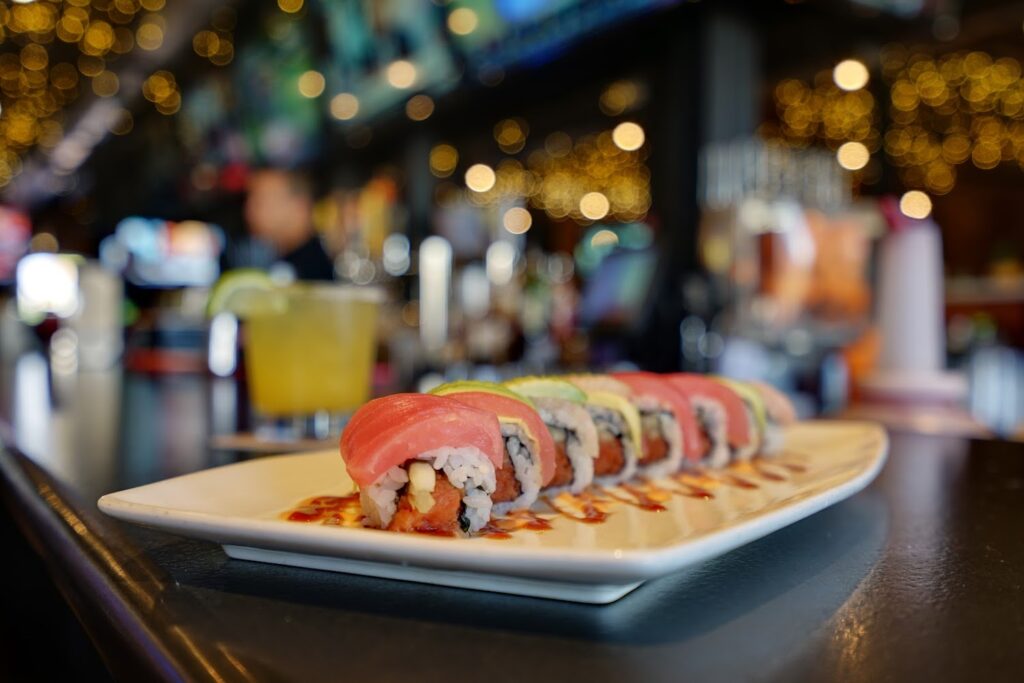Whether you’re a casual sushi eater or a passionate foodie, there’s a good chance you’ve unknowingly broken a few sushi etiquette rules. Sushi is more than just a meal—it’s a cultural experience deeply rooted in Japanese tradition. While dining customs may be more relaxed in the U.S., understanding the basics of sushi etiquette can elevate your experience and show respect for the chefs who prepare it.
In this guide, we’ll cover 10 common mistakes people make when eating sushi in America—from mixing wasabi with soy sauce to where you place your chopsticks. Whether you’re dining at a local favorite or trying omakase for the first time, these tips will help you eat like a pro and make your sushi nights more enjoyable.
Want to put your new skills to the test? Visit our Sushi Restaurant Directory to find top-rated sushi spots near you.
1. Mixing Wasabi into Your Soy Sauce
While it’s common in the U.S., traditional sushi etiquette frowns upon mixing wasabi into your soy sauce. Why? Because it can overwhelm the flavor of the fish and disrespect the chef’s intended balance of flavors.
- What to do instead: Dab a small amount of wasabi directly onto the fish—especially if you’re not served it already seasoned.
- Tip: High-end omakase chefs often season each piece for you—no soy or wasabi needed.
2. Eating Sushi with a Fork
Although not a cardinal sin, using a fork to eat sushi takes away from the cultural and tactile experience. Sushi is traditionally eaten with chopsticks—or even with your hands!
- Yes, hands are okay: It’s perfectly acceptable to eat nigiri and rolls with your fingers, especially in more casual settings.
- When to use chopsticks: For sashimi (slices of raw fish without rice) or when the sushi is more delicate.
Learn more about sushi types in our Beginner’s Guide to Sushi.
3. Dipping Rice Side First in Soy Sauce
This is one of the most common etiquette slip-ups. Dipping the rice side into soy sauce causes it to fall apart and absorb too much soy—masking the delicate flavor of the fish.
- Proper technique: Turn the nigiri on its side and lightly dip the fish side into the soy sauce.
- Bonus: This keeps your hands clean if you’re eating with your fingers.
4. Placing Chopsticks Upright in a Bowl
Sticking chopsticks upright in rice or any bowl is considered bad luck in Japanese culture—it resembles a funeral ritual.
- Instead: Lay your chopsticks across your plate or use the chopstick rest provided.
- Never: Cross your chopsticks or point them at someone while speaking.
5. Ignoring the Chef’s Role
At sushi bars, especially in omakase-style dining, the chef is not just preparing your meal—they’re curating a personalized experience. Talking to the sushi chef with respect shows appreciation for their craft.
- Use honorifics like “Itamae” (sushi chef): A simple “thank you” goes a long way.
- Avoid excessive requests: Let the chef guide your journey if you’re doing omakase.
6. Overloading Rolls with Sauces and Ginger
It might be tempting to add spicy mayo or layer on pickled ginger, but these are palate cleansers—not toppings.
- Use ginger between bites: Especially when switching from one type of fish to another.
- Reserve sauces for rolls meant to have them: Many chefs use sauces sparingly to enhance—not drown—flavor.
7. Ordering All at Once in an Omakase Setting
In omakase (chef’s choice) meals, the pacing is just as important as the ingredients. Placing a massive order upfront disrupts the flow of service and the chef’s intended progression.
- Let the chef lead: Omakase is about trust. Allow the chef to serve dishes in the best order.
8. Not Finishing Each Piece in One Bite
Nigiri and most sushi rolls are crafted to be eaten in a single bite. Biting them in half can cause the piece to fall apart—and is considered improper form.
- One bite rule: Take in the full flavor profile as intended by the chef.
- Struggling with size? Ask your chef if smaller pieces can be prepared.
9. Taking Too Long to Eat Sushi After It’s Served
Sushi is meant to be eaten immediately after it’s made. The temperature of the fish and rice, as well as the texture, can change quickly.
- Best practice: Don’t let it sit—eat it right away to enjoy the optimal flavor.
10. Not Saying “Thank You” in Japanese
While not mandatory, saying “thank you” in Japanese is a thoughtful gesture, especially if you’re seated at the sushi bar.
- Say “Arigatou gozaimasu” (pronounced: ah-ree-gah-toh goh-zai-mas): polite and always appreciated.
—
Final Thoughts: Respect the Craft, Enjoy the Experience
Sushi is more than just raw fish and rice—it’s an art form built on centuries of tradition and meticulous craftsmanship. While American sushi culture is often more relaxed, understanding basic etiquette shows respect for the chef and enhances your dining experience.
Quick Recap:
- Don’t mix wasabi into soy sauce
- It’s okay to eat sushi with your hands
- Avoid sticking chopsticks upright in rice
- Talk to the chef with respect
- Eat sushi promptly and in one bite
Ready to put your sushi etiquette to the test? Explore top-rated local sushi bars, omakase experiences, and chef-led spots at SushiSeek.com. We’ll help you find the perfect sushi destination—whether you’re at home or on the road.

